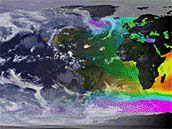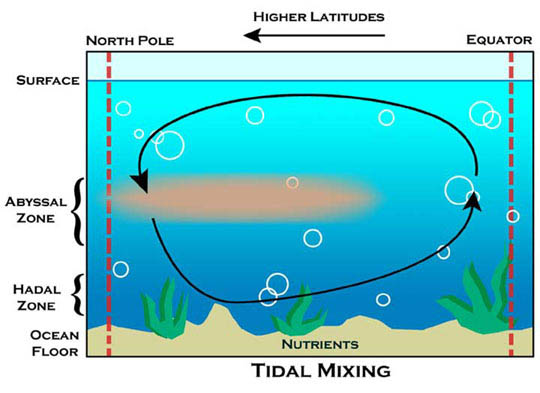

 |
by Rosana Hemakom January 24, 2001 |
||
|
With two-thirds of the Earth covered by water, it is impossible not to recognize the enormous impact the oceans have on our planet's climate. The ocean and its relationship with climate remains, in many ways, a mystery. But, with altimeter data from the TOPEX/Poseidon satellite, scientists can better gauge the impact of the oceans on climate change. (TOPEX/Poseidon data are available at the JPL DAAC and through the TOPEX/Poseidon web site.)
|

 TOPEX/Poseidon scanning the Earth. (Image courtesy of Jet Propulsion Laboratory)  Ocean images translate to a model. (Image courtesy of Jet Propulsion Laboratory) The objective of the highly successful TOPEX/Poseidon mission, launched in August 1992 and currently operating, is to determine ocean topography with a sea surface height measurement precision of 3 centimeters and a sea level measurement accuracy of 13 centimeters. For more information, visit:
|
Global climate, the long-term measurement of weather patterns, is a combination of the behavior of the terrestrial biosphere, the atmosphere and the oceans. Scientists have recognized the role of the ocean in controlling climate change through its storage and transport of heat and liquid water. The longer the satellite record, the more it appears that oceans play a large role in climate change.
"The ocean is a major element in the Earth's climate," said Carl Wunsch, professor of Physical Oceanography at Massachusetts Institute of Technology. "If we don't understand it far better than we do now, we are never going to be able to predict what the future holds. In order to understand climate change, it is important to know what is going on in the deep ocean because of its connection to the rate of heat movement between the poles," he said. "TOPEX/Poseidon is essential to this." Launched in 1992, TOPEX/Poseidon measures changes in sea level, which responds to heat at any depth. By combining these data with modern general circulation models, scientists are seeing a difference between actual measurements and a long-held theory that the ocean warms primarily at the surface. Now, scientists say that waters midway between the surface and the floor are heating up the fastest. They are concerned that disproportionately heating the middle depths of the ocean will dramatically alter the current patterns that allow nutrient-rich waters from the bottom to mix and intermingle with surface waters. "Ocean mixing is a far more complex 'engine' than was appreciated before," said Wunsch, who has studied the ocean for 30 years. "It carries grave consequences not just for climate, but also for the biology and chemistry of the ocean." Wunsch and colleague Walter Munk, of the Scripps Institute of Oceanography at the University of California - San Diego, used TOPEX/Poseidon data to estimate the rate at which the abyssal ocean mixes and the power required to sustain this mixing. Before the mid-1800s, the term "abyssal zone" referred to depths beyond the reach of fishermen, but later scientists restricted its meaning to the deepest regions with a uniform fauna and low temperatures, distinguishing it from overlying (bathyal or archibenthal) zones with more varied fauna and higher temperatures. Eventually an underlying (hadal) zone was defined for areas in trenches and deeps below 6,000 to 7,000 meters. The upper boundary of the abyssal zone ranges between 1,000 to 3,000 meters, with the position of the 4 degrees Centigrade isotherm generally considered the demarcation line. The abyssal zone is the world's largest ecological unit, with depths exceeding 2,000 meters comprising more than three-quarters of the world ocean. | |
 According to scientists at the Jet Propulsion Laboratory, the middle depths of the Pacific Ocean are warming faster than the surface waters. TOPEX/Poseidon data used in concert with a general circulation model suggest that disproportionate warming of the Abyssal Zone could interfere with the ocean's circulation patterns. If it occurs, such a disruption could severely impact the marine food chain by depriving phytoplankton of nutrients that are usually swept up from the bottom by upwelling currents. Changing the ocean's circulation patterns could also have a significant impact on climate. (Cartoon courtesy Hailey King) | |||
|
Abyssal mixing is the turbulent exchange of deep water with surrounding ocean fluid. The search for causes of deep mixing is now one of the most important research areas in physical oceanography. Wunsch and Munk investigated the possibility of wind and tides as important, and even dominant, elements in mixing the deep ocean. Numerous studies have indicated that turbulence in the deep ocean is too weak to mix the fluid, he said.
Past research has suggested that mixing occurs at the oceans' coastal boundaries, and fluid is transported to the interior by processes not yet completely understood. "The idea that tidal dissipation (of nutrients and sediments) takes place in shallow seas was suggested about 1918 and has been thought true since then," Wunsch said. "It's only with TOPEX/Poseidon data that some of us began to think it need not be completely true." His research has led Wunsch to believe that tidal dissipation in shallow water has no significant effect on ocean circulation. Instead, his use of TOPEX/Poseidon altimetry data with dynamic models suggests that enough heat energy is available to explain abyssal mixing, especially if the ocean is viewed as a system driven by winds and tides. "Meridional overturning circulation" is the basic thermal- and salt-driven circulation that occurs on a global scale. The pattern is usually a sinking motion at high latitudes and a rising motion at the equator. This circuit, where cold water that sinks at high latitudes eventually warms and rises to the sea surface nearer the tropics, carries a great deal of heat. The strength of meridional overturning circulation, and the amount of heat transported, is intimately tied to the distribution and intensity of ocean mixing. The link between meridional overturning circulation and ocean mixing processes has been known for years. However, most discussions of the two processes have been made exclusive of one another, Wunsch said. If the mixing rate — or the energy available to effect circulation — changes, then the rate of water movement changes as well. Once the water movement is altered, the rate of heat movement is modified. If this change occurs significantly in either direction, climate change could occur. Wunsch's concept is that the ocean's mixing is mechanically driven by winds and tides, rather than driven by temperature variations in the water. Actually, he says, tidal motions directly produced by ocean heating are negligible. Wunsch points out that there is a big difference between a system in which winds and tides control the rate of mixing currents, and a system in which water transport is merely a function of its temperature. "Think of a horse trailer. A truck transports the horse. The horse could have been the cause of the motion, but it isn't in fact." Similarly, warm water could cause some movement, but in fact the warm water itself is moved mostly by winds and tides. Looking at the importance of deep sea mixing and the ocean as a "mechanically driven system" are two ways TOPEX/Poseidon has played a crucial role in understanding changes in the Earth's oceans. Altimeter data from the satellite will continue to allow scientists to explore the depths of oceanography and climate change. "We can see that the ocean is undergoing rapid and continuous change, day by day," Wunsch said. "This is in striking contrast to the pre-TOPEX/Poseidon view that the ocean changed only very slowly and on the largest spatial scale. We only hope for the ability to continue these projects. Without them, we go back to being blind." Munk, W. And Carl Wunsch. 1998. Abyssal recipes II: energetics of tidal and wind mixing. Deep-Sea Research I 45:1977-2010 |
|||